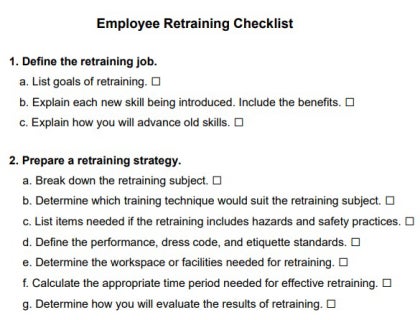
Retrain Employees Checklist Download:
Download this free employee retraining checklist in PDF format.
Download NowEmployee Retraining Checklist:
1. Define the retraining job.
a. List goals of retraining.
b. Explain each new skill being introduced. Include the benefits.
c. Explain how you will advance old skills.
2. Prepare a retraining strategy.
a. Break down the retraining subject.
b. Determine which training technique would suit the retraining subject.
c. List items needed if the retraining includes hazards and safety practices.
d. Define the performance, dress code, and etiquette standards.
e. Determine the workspace or facilities needed for retraining.
f. Calculate the appropriate time period needed for effective retraining.
g. Determine how you will evaluate the results of retraining.
3. Determine costs for the retraining program.
a. Include costs for facilitators, equipment, learning material, supplies, etc.
b. If you don’t have training space at your office, include location costs.
c. Calculate the wages of all employees attending the training.
d. If you plan on providing lunch or snacks, add them to the budget.
4. Inform your employees.
a. Define why retraining is needed.
b. List the goals of the retraining.
c. Provide the date, time, and location.
d. Explain the performance, dress code, and etiquette standards.
e. Give the time period for retraining.
f. Explain how the retraining will benefit the employee and company.
5. Hire an instructor.
a. Decide if you'll use an instructor from the company or outsource a professional facilitator.
b. Look at the experience and abilities of the instructor.
c. Test the knowledge and skills of the instructor.
6. Review training material.
a. Compare previous training material and look for improvements.
b. Prepare presentations and learning modules.
c. Include visuals and games.
d. Check the supplies needed for safety and hazardous training.
e. Prepare final tests to evaluate retraining success.
7. Evaluate retraining results and inform employees.
a. Review the training tests to evaluate outcomes.
b. Discuss the retraining goals and outcomes with employees.
c. Inform employees about future goals post retraining.
d. Discuss retraining with employees and ask for feedback.
How to Effectively Retrain Employees:
1. Define the retraining subject.
During the retraining process, you'll be responsible for managing your employee’s knowledge, skill, and ability to perform the new task or follow new policies while training. Therefore, it's important that you accurately define the goals and intention of the retraining.
2. Make sure it's directed at the right department.
If you're updating your payment processes with new machinery in a hospital, you wouldn't send your nursing staff on a retraining program. Target the right department or group of employees and ensure there is a real need for retraining.
3. Make retraining engaging and fun.
Training does not have to be dull. Encourage a social environment that welcomes conversation and teamwork. Make sure there are sufficient breaks and room for socializing.
4. Discuss feedback and outcomes with employees.
Once retraining is completed, discuss the outcomes with your employees. Through an open conversation, you can identify room for improvement, collect feedback, and brainstorm suggestions for future retraining.
5. Introduce a system that recognizes achievements.
During the retraining process, employees may excel in certain areas. For example, employees may show great leadership and communication skills. Create a system that recognizes achievements and great work.
Benefits of Retraining:
Employer | Employee |
|---|---|
Improved working environment, products, and services. | Skills development. |
Fresh outlook. | Improve career prospects. |
Better team morale. | Increased job satisfaction. |

